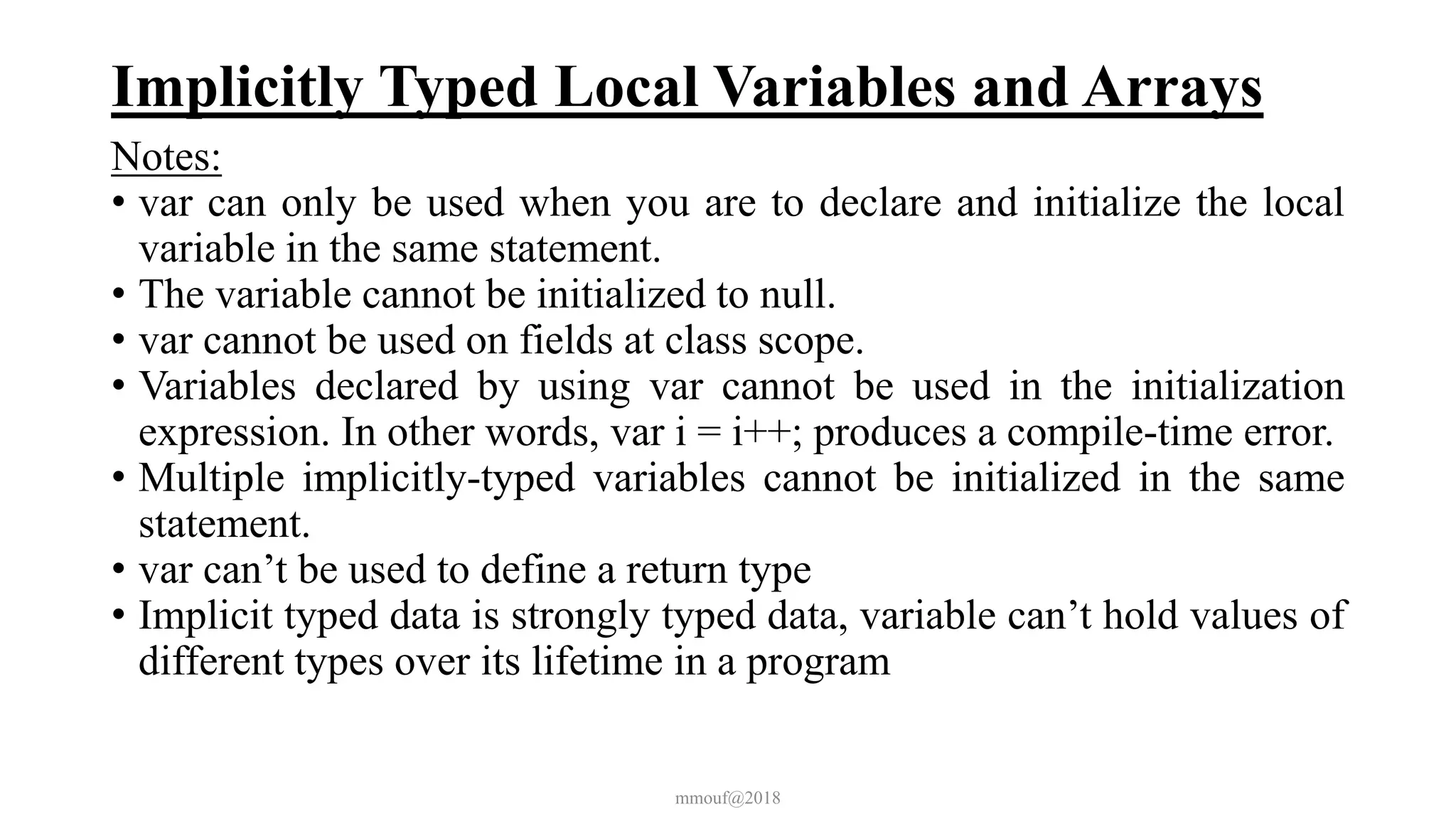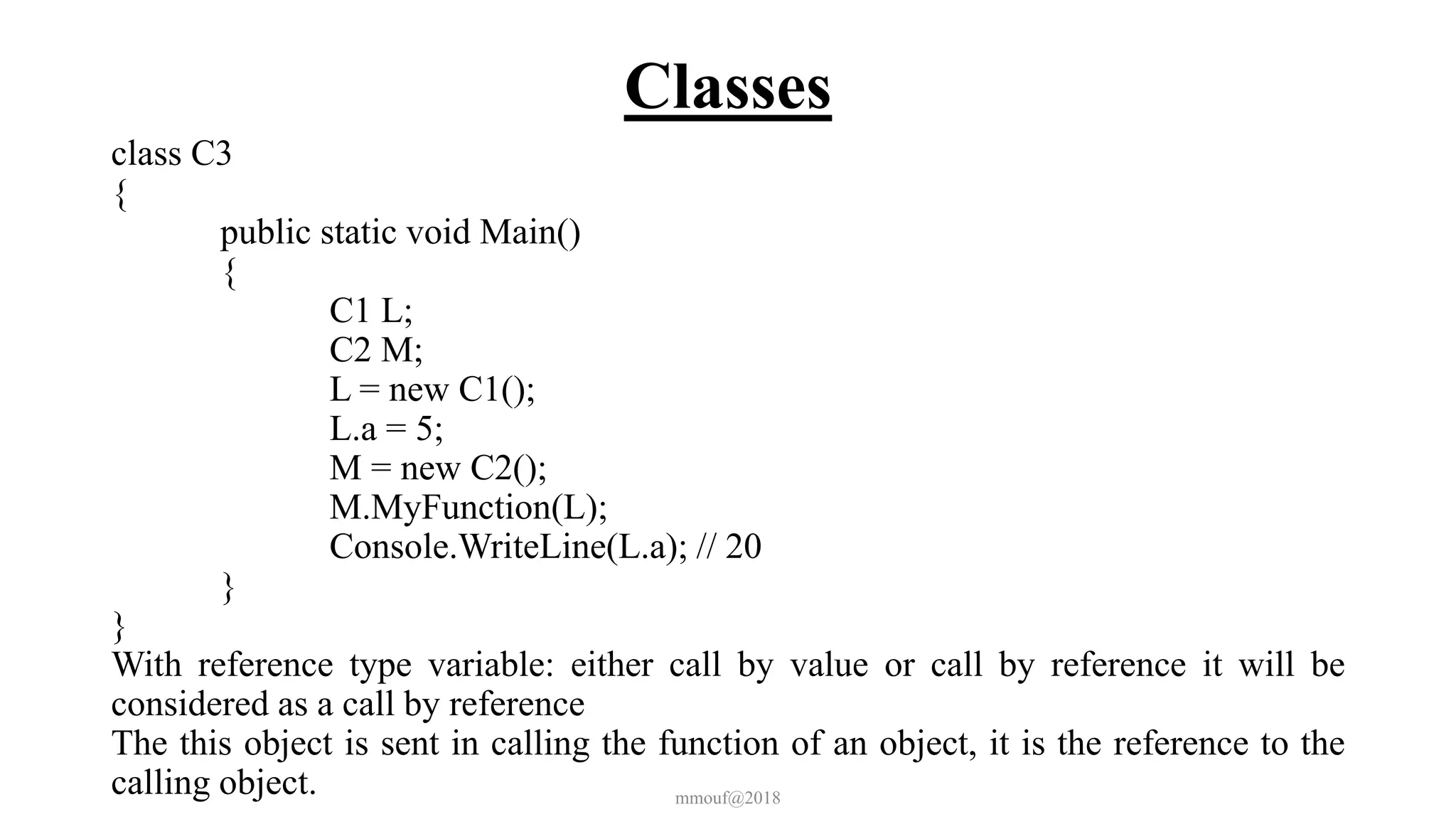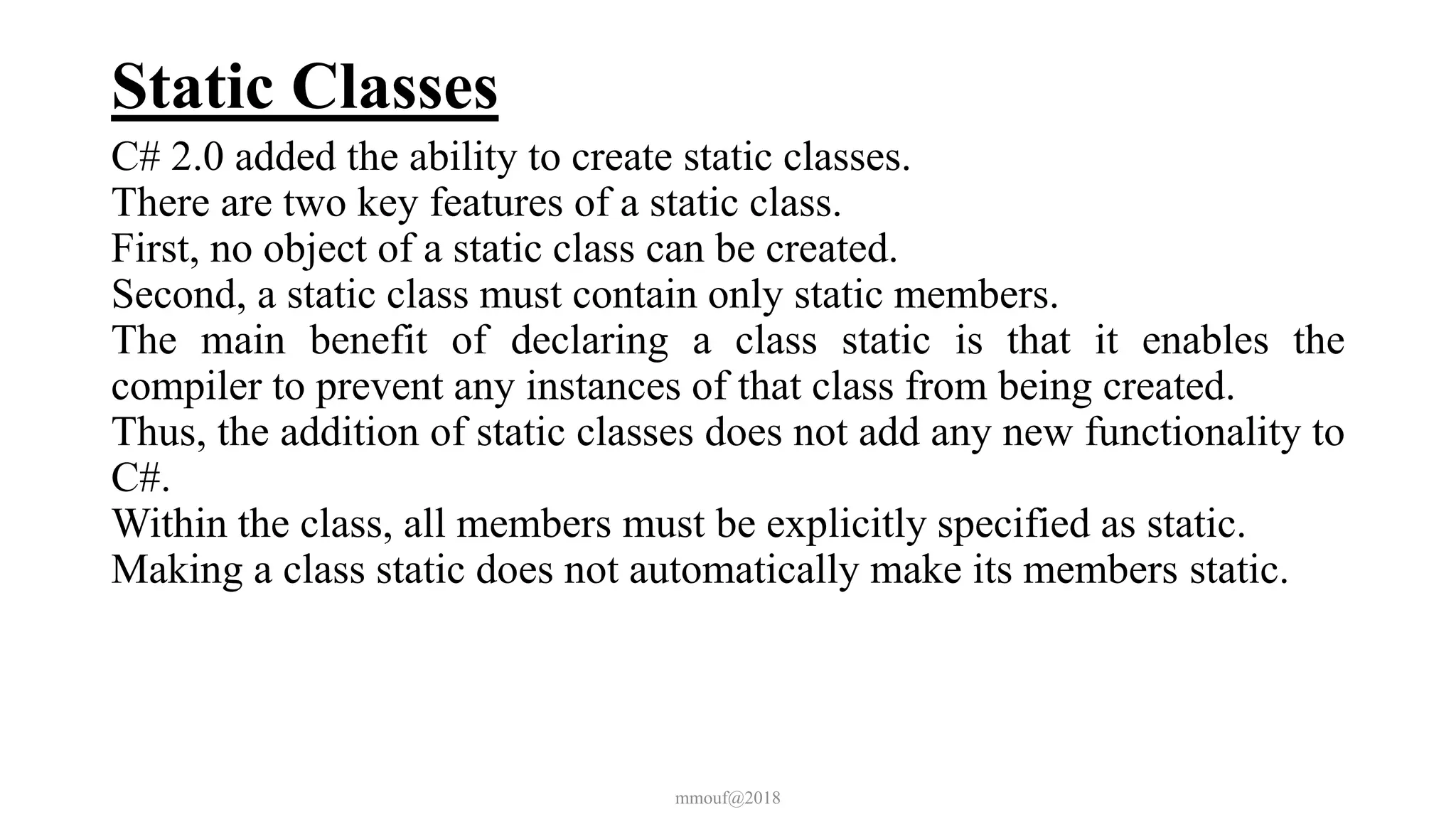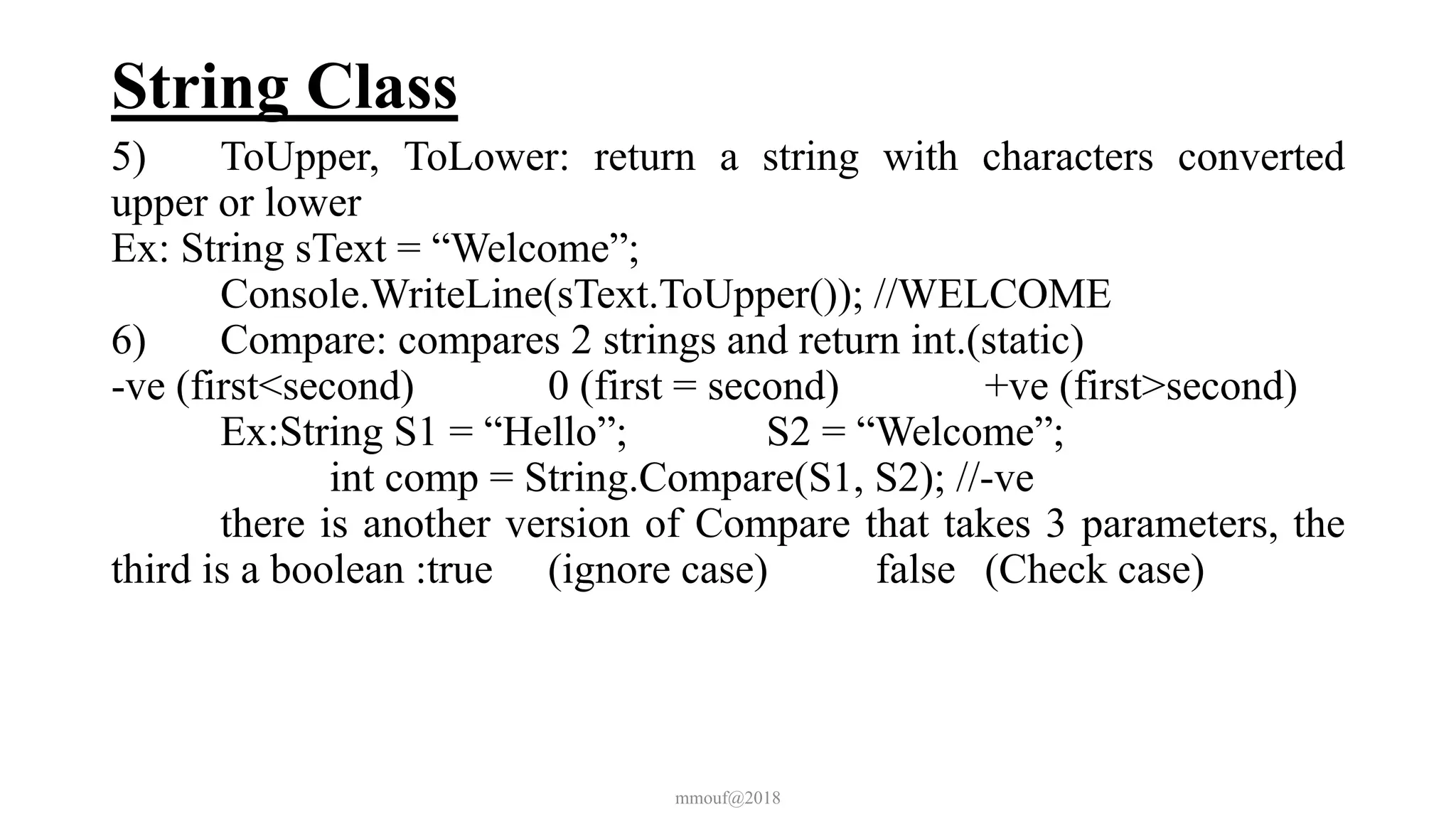The document discusses arrays and classes in C#. It describes that arrays are sequences of data of the same type that can be accessed by index. Classes define common behaviors and attributes with members that must have access modifiers. The document also explains properties of arrays like length, rank, and methods; and string class methods such as insert, length, copy, and compare.

![Array
Arrays are sequence of data of the same data type. You can access an
individual element of an array by means of its position (index).
In C#, array notation is very similar to that used by C/C++ but it differs
in two things:
• You can't write square brackets to the right of the variable name.
• You DON'T specify the size of array when declaring it.
All C# array are derived from the System.Array base class.
To define an array, this is done in 2 steps:
1. declare array
2. create array
The general form of declaring an array:
Data_type[] array_name;
The size of an array is established when it is created not when it is
declared.
mmouf@2018](https://image.slidesharecdn.com/intake383-180109134320/75/Intake-38-3-2-2048.jpg)

![Single Dimension Array
string[] books; //declare
books = new string[3]; //create array of 3 element
OR
Books = new string[3] {"C#", "DotNet", "VB.Net"}; //create and init
OR(Declare and create at 1 step)
string[] books = {"C#", "DotNet", "VB.Net"}; //will set the array 3
OR(Declare and create at 1 step)
string[] books = new string[3]{"C#", "DotNet", "VB.Net"};
mmouf@2018](https://image.slidesharecdn.com/intake383-180109134320/75/Intake-38-3-4-2048.jpg)
![Two Dimension Array
int[,] grid;
grid = new int [2, 3];
grid[0, 0] = 5;
grid[0, 1] = 4;
grid[0, 2] = 3;
grid[1, 0] = 2;
grid[1, 1] = 1;
grid[1, 2] = 2;
Create and initialize:
int[,] grid = {{5, 4, 3}, {2, 1, 0}};
OR
int[,] grid = new int[2, 3]{{5, 4, 3}, {2, 1, 0}};
mmouf@2018](https://image.slidesharecdn.com/intake383-180109134320/75/Intake-38-3-5-2048.jpg)
![Two Dimension Array
Declaration is important in compilation. While creation is done at
runtime
So, you can make the size of array variable, which is very similar to
Dynamic allocation.
Example:
int rows;
int col;
Console.WriteLine(“Enter number of rows”);
rows = int.Parse(Console.ReadLine());
Console.WriteLine(“Enter number of columns”);
col = int.Parse(Console.ReadLine());
int[,] ar;
ar = new int[rows, col];
mmouf@2018](https://image.slidesharecdn.com/intake383-180109134320/75/Intake-38-3-6-2048.jpg)
![Jagged Array
C# also allows you to create a special type of two-dimensional array
called a jagged array.
A jagged array is an array of arrays in which the length of each array
can differ.
A jagged array can be used to create a table in which the lengths of the
rows are not the same.
Jagged arrays are declared by using sets of square brackets to indicate
each dimension.
For example, to declare a two-dimensional jagged array, you will use
this general form:
type[ ] [ ] array-name = new type[size][ ];
Here, size indicates the number of rows in the array.
The rows, themselves, have not been allocated. Instead, the rows are
allocated individually. This allows for the length of each row to vary.
mmouf@2018](https://image.slidesharecdn.com/intake383-180109134320/75/Intake-38-3-7-2048.jpg)
![Jagged Array
Example:
int[][] jagged = new int[3][];
jagged[0] = new int[4];
jagged[1] = new int[3];
jagged[2] = new int[5];
Once a jagged array has been created, an element is accessed by
specifying each index within its own set of brackets.
For example, to assign the value 10 to element 2, 1 of jagged, you
would use this statement:
jagged[2][1] = 10;
mmouf@2018](https://image.slidesharecdn.com/intake383-180109134320/75/Intake-38-3-8-2048.jpg)
![Properties of Array
Length: returns number of element in the array.
Example:
int[] x;
x = new int[7];
int y = x.Length; //y = 7
int[,] a;
a = new int[3, 4];
int b = a.Length; //b = 12 (3*4)
Rank: return the dimension of array
Example:
int z = x.Rank; //z = 1;
int c = a.Rank; //c = 2;
mmouf@2018](https://image.slidesharecdn.com/intake383-180109134320/75/Intake-38-3-9-2048.jpg)
![Properties of Array
Sort(): sort an array
System.Array.Sort(array_name); //sort the array
Clear(): set a range of elements in the array to zero, false or null
reference
System.Array.Clear(array_name, starting_index, numberofelement);
Clone(): this method creates a new array instance whose elements are
copies of the elements of the cloned array.
int[] cl = (int[])data.Clone();
If the array being copied contains references to objects, the
references will be copied and not the objects. Both arrays will refer to
the same objects
mmouf@2018](https://image.slidesharecdn.com/intake383-180109134320/75/Intake-38-3-10-2048.jpg)
![Properties of Array
GetLength(): this method returns the length of a dimension provided as
an integer.
Ex: int [,] data = {{0, 1, 2, 3}, {4, 5, 6, 7}};
int dim0 = data.GetLength(0); //2
int dim1 = data.GetLength(1); //4
IndexOf(): this method returns the integer index of the first occurrence
of a value provided as argument or -1 if not found. (used in 1-dimension
array)
int[] data = {4, 6, 3, 8, 9, 3};
int Loc – System.Array.IndexOf(data, 9); //4
A method may return array:
mmouf@2018](https://image.slidesharecdn.com/intake383-180109134320/75/Intake-38-3-11-2048.jpg)
![Properties of Array
The C# allows you to iterate over all items within a collection (ex:
array,…)
int []ar = new int[]{0, 1, 2, 3, 4, 5};
foreach(int I in ar)
{
Console.WriteLine(i);
}
You can’t modify the elements in a collection by using a foreach
statement because the iteration variable is implicitly readonly.
foreach(int i in ar)
{
i++ ; //compile time error
Console.WriteLine(i);
}
mmouf@2018](https://image.slidesharecdn.com/intake383-180109134320/75/Intake-38-3-12-2048.jpg)
![Implicitly Typed Local Variables and Arrays
We can declare any local variable as var and the type will be inferred by
the compiler from the expression on the right side of the initialization
statement.
This inferred type could be:
Built-in type
User-defined type
Type defined in the .NET Framework class library
Example:
var int_variable = 6; // int_variable is compiled as an int
var string_variable = “Aly"; // string_variable is compiled as a string
var int_array = new[] { 0, 1, 2 }; // int_array is compiled as int[]
var int_array = new[] { 1, 10, 100, 1000 }; // int[]
var string_array = new[] { "hello", null, "world" }; // string[]
mmouf@2018](https://image.slidesharecdn.com/intake383-180109134320/75/Intake-38-3-13-2048.jpg)







